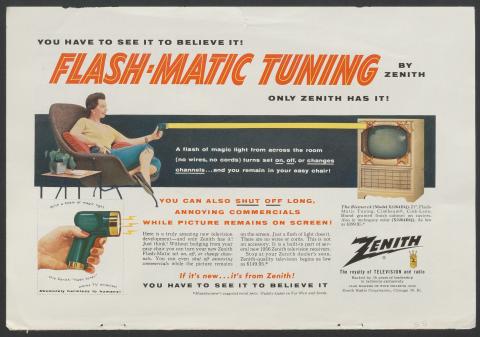
You have to see it to believe it! Today's #TechTuesday is truly amazing and, what's more, absolutely harmless to humans!
This 1955 advertisement marketed Zenith Radio Corporation's Flash-Matic television and flash tuner remote control. The company, founded in 1918 as Chicago Radio Labs, began its corporate life manufacturing parts for amateur radio devices. It was formally incorporated in 1923 as Zenith Radio Company, a name derived from it's founders' ham radio call sign - 9ZN (or ZN'th).
As the company grew, so too did its product lines. Zenith introduced the world's first portable radio in 1924 and was also pioneered in introducing home radio receivers that could operate on household electric currents (1926) and automatic push-button radio tuning (1927), and established the first FM radio station in the Midwest (1940).
Zenith's entry into the world of television manufacturing began in 1939, and the company began selling commercial sets to the public in 1948. The Flash-Matic system seen here is the world's first commercial wireless remote control for a television console, and superseded the company's 1950 "Lazy Bones" wired remote control model.
Development of the Flash-Matic is credited to Zenith engineer Eugene Polley (1915-2012), whose career in the company began with a stock boy position in 1935 and ended in 1982, when he retired from the position of Assistant Division Chief for Zenith's Mechanical Engineering Group. The gadget worked by aiming a beam of visible light at four photo cells, each located in a different corner of the console, and each assigned a different task. The cells could turn the television on and off, mute the sound, and change the channel up or down.
This item is part of the Alexander Magoun advertising collection subseries of Hagley Library's David Sarnoff Library collections (Accession 2464). David Sarnoff (1891-1971) was president of the Radio Corporation of America (RCA), one of the country’s leading manufacturers and vendors of radios, phonographs, and televisions. He established the David Sarnoff Library to house his private papers and professional records.
The collections developed further with the acquisition of papers of former RCA executives, scientists, and engineers, including Alexander Magoun, curator for the David Sarnoff Library from 1998 until 2000. Hagley Library obtained the Sarnoff collection records shortly after the Sarnoff Corporation closed the library in 2009. The College of New Jersey obtained the museum objects.
To view a selection of material digitized from this collection, click here to visit its page in our Digital Archive.

